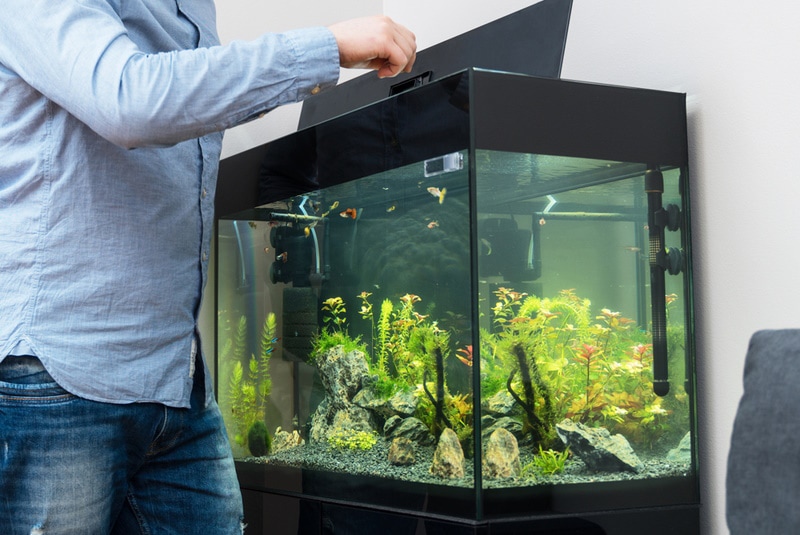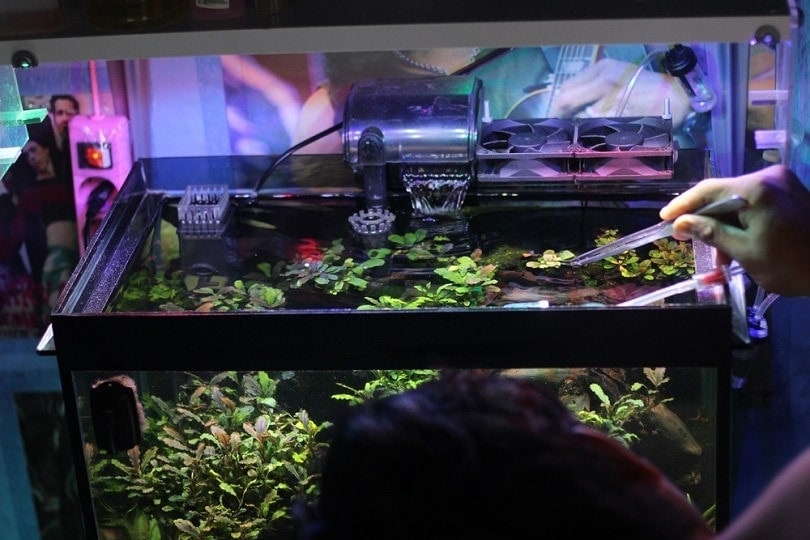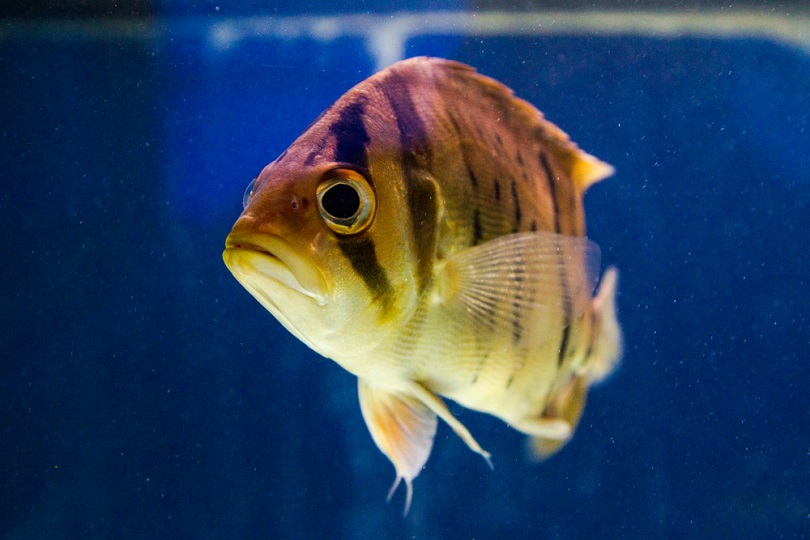Rummy Nose Tetra: Vet-Approved Care, Pictures, Food, Lifespan & Tank Setup Info
Updated on
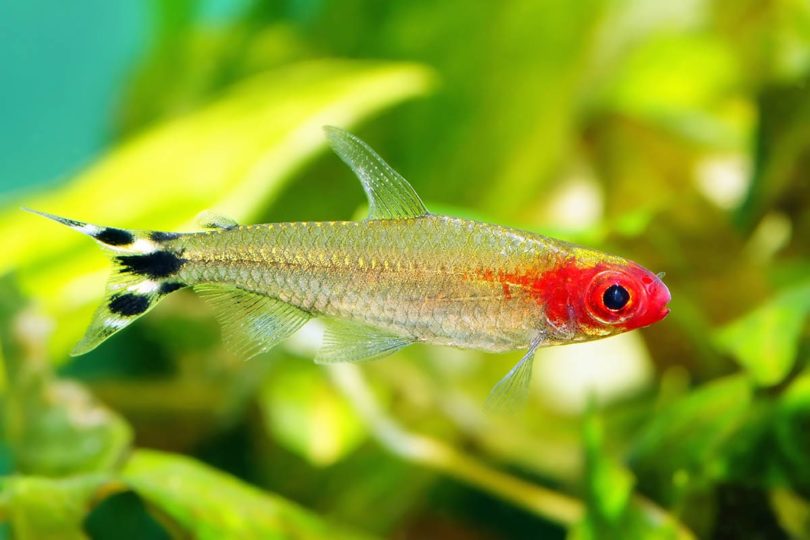
Click to Skip Ahead
There’s a whole world of tetras that have made their way into the fishkeeping hobby. Because of how many options there are available, there are some varieties that most people know about, like neon tetras. Although the rummy nose tetra is often counted among the most popular fish sold in fish and pet stores, many people don’t know very much about it. This beautiful fish has an easy care level (assuming you’re not keen on breeding them), so it’s important to learn everything you can about them before bringing rummy nose tetras home.
Rummy Nose Tetra Fish Overview
| Species Name: | Petitella rhodostoma, Petitella bleheri, or Petitella georgiae |
| Family: | Characidae |
| Care Level: | Easy when not being raised for breeding |
| Temperature: | 23 – 26 °C (73.4 – 79 °F) |
| Temperament: | Peaceful, schooling |
| Color Form: | Translucent to silver body, hyaline fins, red coloration on face, striped tail. |
| Lifespan: | 5 years (estimation) |
| Size: | 2 inches (5 centimeters) max |
| Diet: | Omnivore |
| Minimum Tank Size: | 20 gallons for a school of 10 |
| Tank Set-Up: | Tropical freshwater, planted preferred |
| Compatibility: | Peaceful, non-predatory tropical freshwater fish |
The rummy nose tetra is a reference to one of three species of fish in the genus Petitella. Within the aquarium hobby, it’s sometimes very difficult to tell them apart, and, when housed together, these three species will readily school with each other.
The rummy nose tetra has been in the fishkeeping hobby for a long time now, and while it is often considered a favorite among experienced fishkeepers, this fish can be a rewarding experience for beginners as well. Although peaceful, these fish are considered to be outgoing and social, bringing life and color to your tank.
Some people even consider the rummy nose tetra to be an aquatic version of a canary in a coal mine because their colors can change when water quality is poor. When toxins such as ammonia and nitrite spike in an aquarium, their face loses their deep red color. The color returns once water quality issues are addressed. Likewise, prolonged periods of a pale face indicate that the water they’re housed in is inappropriate.
Rummy Nose Tetra Breed Characteristics
Rummy Nose Tetra Cost
Like most tetras, the rummy nose tetra is native to South America. Their numbers are unknown in the wild, but they are not considered to be endangered or at risk of becoming endangered at this time.
The rummy noses in the fishkeeping hobby are those raised and bred by humans as pets, not wild-caught. Ask the seller about the origin of your fish before bringing them home. Wild-caught fish are often susceptible to exposure to different parasites and illnesses than pet fish. Capturing wild fish also disrupts the ecosystems they exist in and isn’t considered conducive to animal welfare.
When it comes to purchasing rummy nose tetras, you can expect to spend between $2 and $10 per fish. Keep in mind, though, that rummy nose tetras are shoaling fish, so it’s important to keep a group of them at all times. Six fish is the minimum number, but they will be generally better off in larger groups, provided your aquarium can handle the numbers.
Online retailers and breeders often require overnight or expedited shipping fees to ensure the live arrival of your fish, so keep this cost in mind as well. You can expect to spend at least $20 on a shoal of rummy noses but may spend upwards of $100, depending on the retailer and any associated shipping costs.
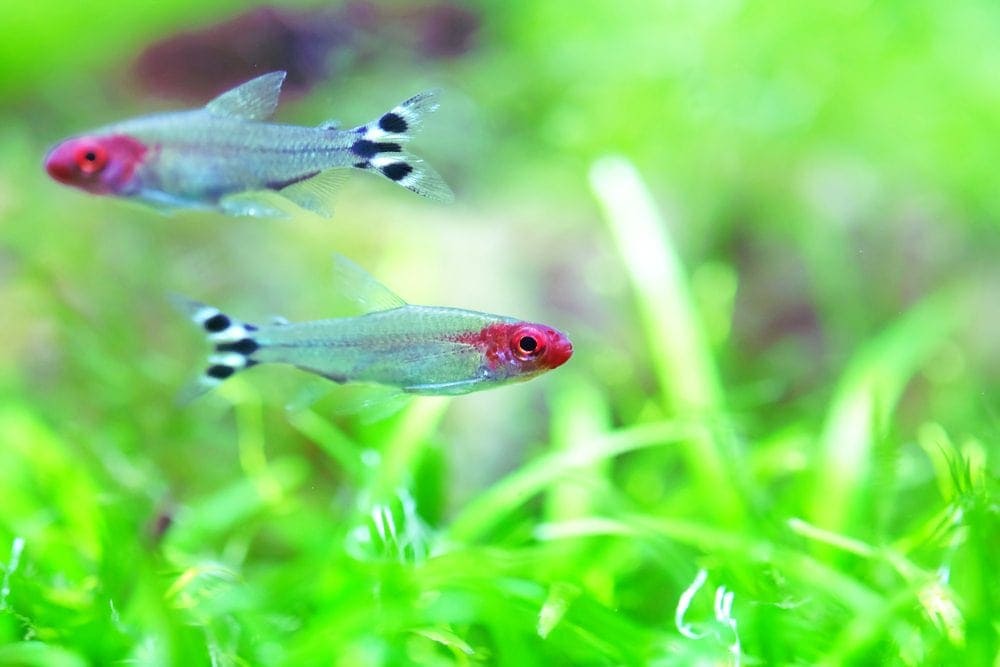
Sociability of the Rummy Nose Tetra
Do These Fish Make Good Pets?
Yes, the rummy nose tetra is a fun fish to keep. They are known for their tight schooling activity, and all of the fish in the school will move in unison. In the wild, this allows them to confuse predators and makes it more difficult for a fish to become singled out. When kept as pets, this is a fun behavior to witness.
Their schooling behavior has been studied and compared to those of other schooling fish. Interestingly, the rummy nose tetra do not operate as a “single unit” when they school, and instead, each individual contributes to the collective decision of the group’s movement patterns based on how they perceive their environment. This allows them to outperform other schooling fish. This ability is attributed to them being more attuned to light gradients than other fish.
Does This Fish Make a Good Tank Mate?
Like many other tetra species, the rummy nose tetra is a very passive fish. They do well in community tanks with other peaceful fish, but it is possible that they will defend themselves against bullies. They are opportunistic eaters, so you should be aware that they may eat smaller tankmates, especially small invertebrates, like shrimp, and the fry of most fish species.
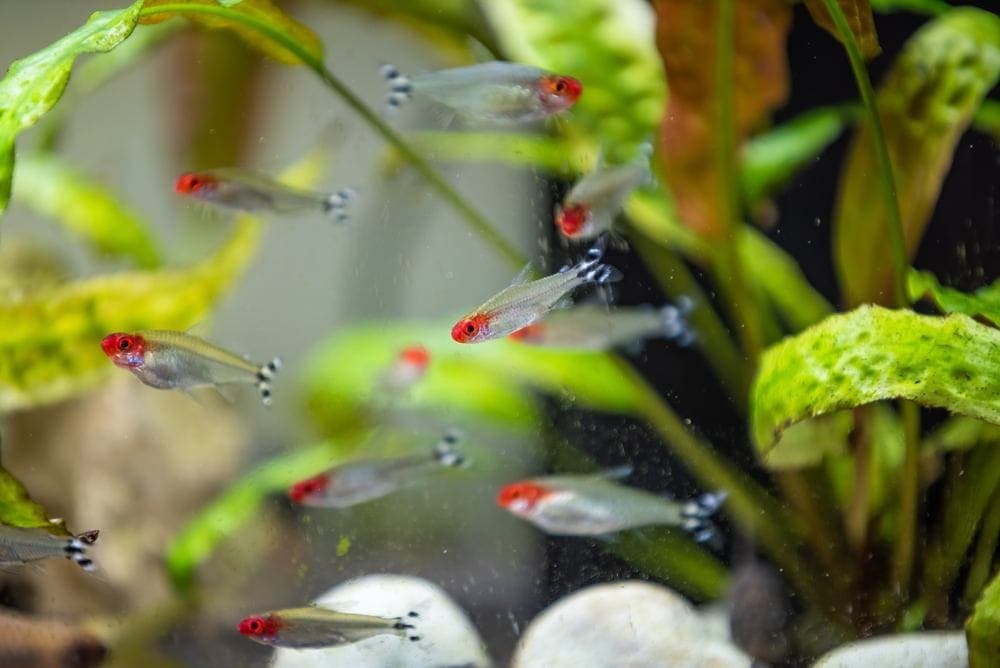
Care Guide & Tank Set Up
Water Quality, pH & Temperature
Rummy nose tetras require high water quality. When water quality is poor, their red noses will begin to lose brightness, allowing you to pick up on issues, potentially before they become a big problem. They are tropical fish, so they need heated water.
When not breeding, they prefer temperatures ranging from 23 – 26 °C (73.4 – 79 °F). They prefer soft, acidic waters, like those found in blackwater tanks, but they can thrive in pH levels from 5.5 to 7.5. Tannin water (also sometimes known as black water) is their preferred environment. This can be achieved by adding tannin-leaching decor, such as driftwood, into their enclosure.
Substrate
When setting up a tank for rummy nose tetras, you should aim to provide lots of live plants and driftwood. Leaf litter, alder cones, and other additives that add tannins to the tank are also great for maintaining a natural environment for them. The substrate can be anything from sand to stones, but it should be able to be used to plant rooted plants. If you use substrate without nutrients, you might need to use other forms of fertilizer for your plants.
Plants
Any plants used in your tank should be able to live in the environment you set up. This means that plants should be able to thrive in blackwater environments with soft water and a low pH. Depending on the tank’s temperature, you may also need to find plants that can withstand warmer-than-usual tank temperatures. Anubias, Java moss, Java ferns, Cryptocoryne, water sprite, Echinodorus, and Bucephalandra are all great options for the rummy nose tetra’s tank.

Lighting
Normal day/night lighting cycles are recommended for rummy nose tetras. The lighting you select should be powerful enough to support the live plants in the tank. Keep in mind that rummy noses naturally live in blackwater environments, which limits the amount of lighting that makes it through the water due to the tannin-tinged water color. Because of this, rummy nose tetras are unlikely to be happy in high lighting.
Filtration
The filtration in your tank should be adequate to properly maintain water quality in the size of the tank and with the number of fish living in the tank. Rummy nose tetras will likely appreciate some water movement, but avoid strong, fast-moving water.
Things to Know When Owning a Rummy Nose Tetra

Food & Diet Requirements
Rummy nose tetras are omnivores, so most high-quality tetra or community fish foods are suitable. Pellets are often recommended over flakes since they may provide better nutrition. You can also offer treats to add variety to their diet, like bloodworms, brine shrimp, and Daphnia.
Size & Growth Rate
These fish can grow to anywhere between 1–2 inches when fully grown. It’s not uncommon for them to stop growing around 1.5 inches, though. You can expect your rummy nose tetra to rapidly grow within the first year of life. However, fish do not have an end point of growth and continue to grow throughout their lives.
Lifespan & Health Conditions
With proper care, rummy nose tetras may live up to 5 years as pets, with some anecdotal claims even exceeding this. High water quality, a good diet, and a low-stress environment are all necessary to support a long lifespan. When housed in poor conditions, these fish quickly lose their red coloration (it turns pale), and if left untreated, they succumb to their ailments, as they aren’t considered exceptionally hardy.
Male vs Female
Male and female rummy nose tetras are very similar in appearance, but males tend to have leaner bodies than females. Females often have a bit of plumpness due to carrying eggs, but this is very hard to appreciate, especially when the fish aren’t breeding. Although colors may differ slightly between males and females, colors can also differ due to stress and illness, so colors should not be considered a reliable indicator of sex.
Final Thoughts
The rummy nose tetra is one of three species of fish that are popular with aquarists and best known for their namesake red-colored “nose.” With a proper commitment to providing excellent care, these fish can definitely prove to be a rewarding experience. Providing them with an appropriate tank setup will help them thrive, but it’s essential to their health that you keep them in a group. Otherwise, they will be susceptible to stress and illness.
Read Also:
Featured Image Credit: Grigorev Mikhail, Shutterstock



